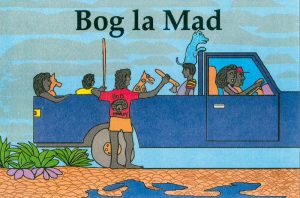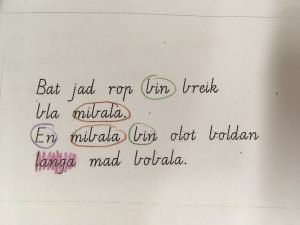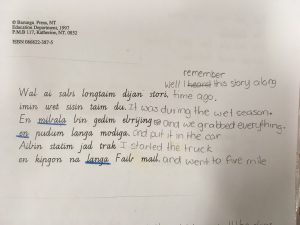Liz Clarkson is a year 9 teacher at Marrara Christian College in Darwin. At the end of 2017 she experimented with using Kriol books from the Living Archive with her class of Indigenous students. Here she describes how she used the materials the second time – see Part 1 for how she initiated the activity the week before.
 The following week the groups followed the same instruction sheet for the Kriol text Bog La Mad (Bogged in the mud) from the Living Archive. I had downloaded the book from the website this time and it was much easier to click through the pages than working directly online. This was great as the pictures are lovely and help with understanding as well.
The following week the groups followed the same instruction sheet for the Kriol text Bog La Mad (Bogged in the mud) from the Living Archive. I had downloaded the book from the website this time and it was much easier to click through the pages than working directly online. This was great as the pictures are lovely and help with understanding as well.
Our most confident Kriol speaker became our ‘consultant,’ so as we worked through the text she corrected as she saw fit, which gave her the role of ‘teacher.’ Then later we compared our translations with the English text that was provided on the last page of the book. That was enlightening for all of us to see if a sentence had been translated with different words or different meaning or perhaps in a more poetic and descriptive way. For example, the translation in the book had ‘exhausted’ but we had used the words ‘weak’ and ‘tired’ which were more literal translations of the text.
Examples of colour-coding and translations of Bog la Mad, with the translation from the book.
Because of the difficulties with the lower group the previous week, I didn’t put the students with lower literacy in a group. Instead I went around to each of them individually while the others went on with their reading activities. With each of them I read through the story in Kriol, they listened and told me what it meant. We discussed the meanings of some different words, and I asked them to give me an oral summary of the story. We used this activity as a basis for comprehension and forming sentences in English based on the Kriol.
In summary here’s what I got out of the activity as a teacher:
- It was a useful diagnostic tool which helped me understand which students understand how to use articles and prepositions in Standard Australian English.
- It showed how students are influenced by their first language.
- It helped me understand better which students could understand Kriol as a common language even though it wasn’t their mother tongue.
- It was interesting to see low literacy students able to listen to Kriol and translate it orally with good accuracy.
- I could experience being the student, as the students could teach pronunciation and meaning to the teacher. This was fun and empowering for the students.
What did the students get out of it?
- Students learnt that there are lots of stories written in Aboriginal languages (not just told).
- Students who were reasonably literate in English could soon get used to how to read Kriol as they were familiar with Kriol sounds and could use English reading skills to decode Kriol.
- Students were able to see how words can be translated in different ways, and see how the grammar of Kriol differs from English.
- It was fun to do an activity that placed value on Aboriginal languages and authors and stories. Students were excited to look up the Living Archive for stories in other languages they knew better or from their home communities.
This is the worksheet used in the class: Instructions for using LAAL books
Do you have a story to share about using materials from the Living Archive? Contact us and we can publish it here, with links from our social media sites.




